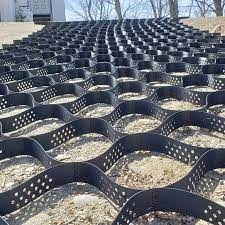
We are well-known geocell suppliers. Our product portfolio includes geotextiles, and geomembranes. It includes geosynthetic clay liners, geo bags, geogrids, geonets. It also has geo composites, geotextile tubes, geocells, geo mats, pipes, storage blocks, umbrella drainage, and PVD. Our extensive product line is well-liked for its simple and easy installation procedure. qualified engineers and workers craft our goods.
Our engineers from top geogrid suppliers stay up to date on the market’s requirements. And adjust the procedure as necessary to satisfy it. They help in giving our customers superior services. Because they are knowledgeable about industrial procedures. They make sure that there is no barrier to the flow of the project. From conception to completion. Everything should be smooth to provide the customer a smooth timeline.
Introduction from Geocell suppliers
Geocell, also known as a cellular confinement system or cellular confinement. It is a three-dimensional geosynthetic material. It is utilized in a variety of civil engineering and construction applications. As top geocell suppliers, Our engineers stay up to date with the needs of the industry. It comprises interconnected high-strength polymer chambers or cells. It is usually constructed of high-density polyethylene (HDPE).
The main aim of geocell is to contain and make the granular fill material more stable. Like soil, sand, or total within their cell structure. A grid or mat with interlocking cells that resembles a honeycomb is there. It limits and strengthens the material it is holding. The cells form a solid, load-bearing structure when they are full.
Main Goal
Geocells’ main goal is to boost soil performance. And increase its capacity for bearing weight. By keeping the fill material contained, geocells increase shear strength. It also prevents lateral spreading and reduces deformation. As a result, they are particularly useful in many operations. Like soil stabilization, erosion control, and maintaining wall construction.
Geocells have many benefits over conventional techniques. Geocell has many benefits. It shortens the construction process and lower expenses. Because they are lightweight, simple to install, and fast deployable. They are also adaptable, making it simple to adjust to uneven terrain. Geocell provides an alternative by reducing the need for unnecessary digging and materials.
Geocell suppliers leading product application
The uses for geocells are many. Geocell suppliers use it in the construction of roads and railroads. Additionally, geocells are used to stabilize riverbanks and safeguard coastal areas from erosion. They also have applications in mining operations, landfills, and environmental cleanup initiatives.
Geocell uses the latest technology from the geocell supplier. This technology helps to provide efficient stabilization of soil. They are an invaluable asset in a variety of civil engineering applications. Because of their adaptability, simplicity of installation, and affordability.
Introduction from Geogrid suppliers
As top geogrid suppliers, it is important to be aware that geogrid is used in civil engineering and construction. It is used to merge soils and other granular materials. It is built of high-strength polymers. Like polyester or polyethylene and has a grid-like structure with spaced pores or perforations.
The main idea of Geogrid is to spread loads to a larger area. This will improve the soil’s ability to support more weight and minimize deformation. It acts as a reinforcement element. It provides strength to the soil.
Geogrid suppliers leading product application
Applications for geogrids include building roads and pavements. It also helps with retaining walls, dams, and slope stabilization. They might be positioned within the soil layers or at the boundary between different soil types. To provide stability and prevent failure under large loads or dynamic stresses.
Geogrid’s main advantages are as follows:
Geogrids serve as reinforcement by greatly boosting the tensile strength of the soil. This reduces excessive settlement and movement. This makes it possible to build on brittle or unstable soils.
Load Distribution:
Geogrids lessen soil stress and the chance of localized failures by dispersing the applied loads across a larger area. They enhance the structure’s functionality by aiding in the
Weight distribution:
Geogrids increase load transfer by forming an interlock with the soil’s particles and stabilizing the soil. This stops lateral spreading, displacement, and soil erosion.
Geocell Vs Geogrid: Is there any difference?
Geocell is a three-dimensional geosynthetic product. It is constructed of interconnected cells or chambers built of high-strength polymer material. Cells that may be filled with soil, sand, or total create a grid-like structure. The main applications of geocells are the building of retaining walls and slope protection. Erosion management, and soil stabilization. They strengthen the fill material. And increase its capacity to bear weight and reduce lateral spreading.
The geosynthetic material is known as geogrid. On the other hand, it has a grid-like structure made up of spaced holes or openings. The most common materials used to create it are high-strength polymers like polyester or polyethylene. Soils and granular materials are strengthened and stabilized using geogrids. To increase tensile strength, distribute loads, and increase stability. Geo Geogrids position themselves within soil layers. Or at the boundary between different soil types. They contribute to the construction of retaining walls, dams, roads, and pavements, as well as the stabilization of slopes.
Conclusion
In conclusion, the two unique geosynthetic materials, geocell, and geogrid, are used in civil engineering. To build projects, reinforce granular materials, and improve soil stability. The Geocell consists of interconnected cells or chambers. That restricts and reinforces fill materials. This way it increases their load-bearing capability. It finds use in processes like soil stabilization and building retaining walls. Geogrid has consistent spacing between its holes and a grid-like construction.
Its primary function is to distribute loads and boost the tensile strength of the soil. It acts as reinforcement and enhances stability. Geogrid suppliers use it in slope stabilization. projects, retaining walls, embankments, and road and pavement construction.
Its main job is to disperse loads evenly. It increases tensile strength in granular and soil materials. Provide reinforcement, and improve stability. Geogrid suppliers use it in slope stabilization projects. Such as retaining walls, embankments, and road and pavement construction.






